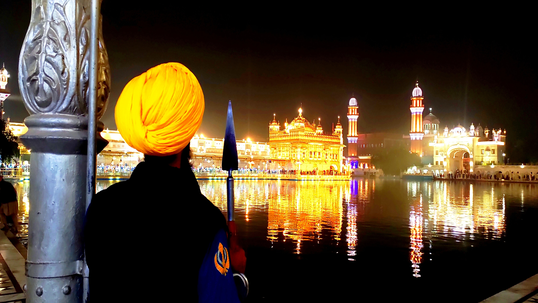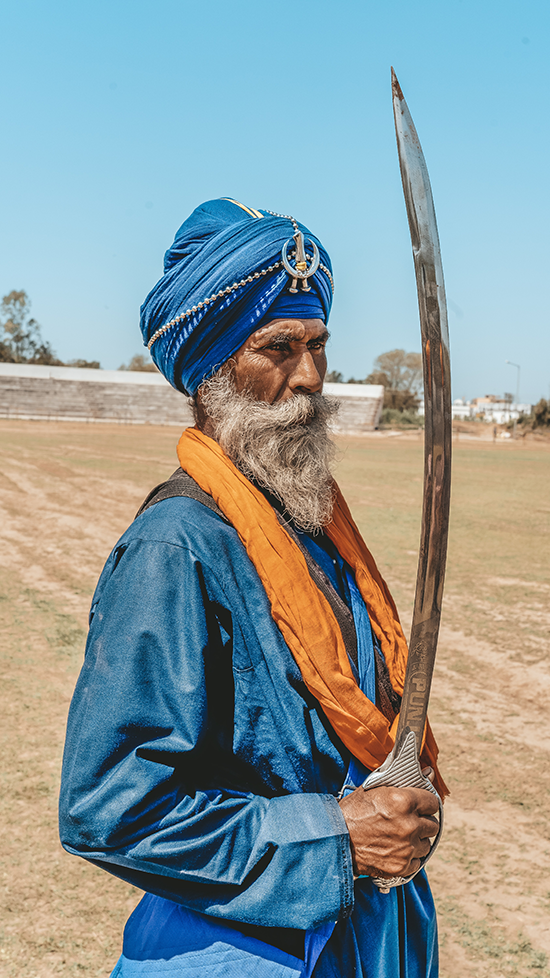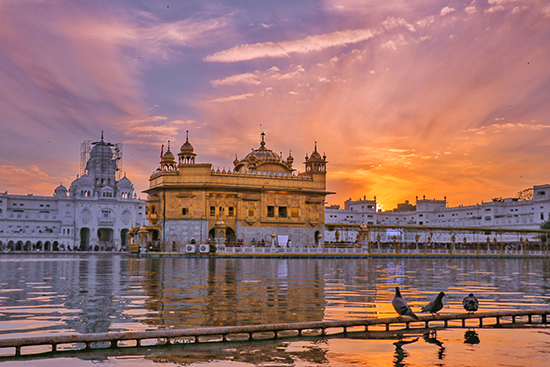
By Suhel Singh Randhawa
ੴ ਸਤਿਗੁਰ ਪ੍ਰਸਾਦਿ
April in Canada is commemorated as the Sikh Heritage Month, a month dedicated to remembering and acknowledging the presence and contribution of the Sikhs (followers of the Sikh religion) to Canadian society and Canadian history.
A Brief History of the Sikhs
The first Guru of the Sikhs, Sri Guru Nanak Dev Ji, starts Sikhi (anglicized to Sikhism) in the Panjab region of South Asia. He rejects the teachings of Islam (state religion) and Hinduism (popular religion) and starts the third faith. After him, came nine Gurus.

A Sikh man in traditional attire, holding a long kirpaan
Who is a Sikh?
While a Sikh can simply be a person who believes solely in the teachings of the Sikh gurus, a true and pure Sikh is someone who has been baptised. Sikh baptism involves taking Khande di Pahul, which translates to “nectar of the double-edged sword.” Such Sikhs form a part of the Khalsa, the purest form of Sikhi created 324 years ago by Sri Guru Gobind Singh Ji, the 10th guru, on April 14, 1699. They are called Amrit dhari Sikhs (Sikhs who have been baptized.) The Sikhs are saint-soldiers, who believe in the use of words and dialogue to resolve issues, but if the need be, they are also willing and able to use weapons to fight for what is right.
They wear five articles of faith:
- Kes - Uncut hair, whether it be scalp hair, facial hair or body hair. It represents the respect for the Akaal Purkh’s creation. An extension of this is the keski or dastaar (turban) that all Sikhs, male and female, must wear to keep their hair in place and keep it covered.
- Kangha - A small wooden comb that a Sikh keeps in their hair. It represents taking care of one’s body, and respecting Akaal Purkh’s creation.
- Kara - A metal bracelet worn on a Sikh’s dominant hand. It serves as a reminder that these hands must never commit a bad deed, must never be raised on the weak, and must never stay down in face of oppression and tyranny.
- Kachera - Long, white briefs that represent sexual maturity and responsibility.
- Kirpaan - A dagger/small sword worn around one’s torso. Arms are an important part of the Sikh faith, and this represents being tyaar bar tyaar (always being ready to defend oneself and others).
Prayers
Amritdhari Sikhs are required to pray three times a day. They wake up before the sun rises, usually around 3–4 a.m., and read five prayers. In the evening, they pray at the time of the sunset, and before going to bed, they say another prayer.
Beliefs
Equality
Sikhs reject any form of discrimination based on caste, creed, gender, and race. The concept of equality is deeply ingrained in Sikhi, as all Sikhs dine together in a Gurdwara, sitting on the ground as equals and having food together. Sikh men have the surname ‘Singh’, which means lion, and Sikh women have the surname ‘Kaur’, which means fearless princess. The holiest shrine of the Sikhs, Harmandir Sahib (anglicised to the Golden Temple), has four doors which signifies acceptance of people from all walks of life.
Concept of God
The Sikhs believe in a singular entity that governs all creation and refer to them as the Akaal Purkh (the Timeless Being). The Akaal Purkh is beyond gender, beyond good and evil, and beyond tangibility. They pervade eras and ages, they are responsible for every action, they are without fear and hatred, and are beyond life and death. All of creation and life forms are manifestations of the Akaal Purkh. The concept of a good God and an evil Devil isn’t held in Sikhi. Instead, the Akaal Purkh pushes both good and evil in the world, keeping a balance between the two, and reminding their creation to act in a good way to uphold righteousness. The Gurus were enlightened souls created and sent by the Akaal Purkh to spread the message of truth, love, and peace.

Sri Harmandir Sahib, Amritsar, the holiest shrine of the Sikhs.
Turbans
Under the Mughal rule, only nobles were allowed to tie turbans. Sri Guru Gobind Singh Ji instructed the Sikhs to tie turbans, and made it a part of their faith, to show that Sikhs do not give in to oppression and are sovereign in expression. The Sikh turban is called dastaar, which means the hand of God. It also represents a distinct identity of the Sikhs in the world. .
Seva
Seva refers to selfless service of humanity, which is reflected in the langar (community kitchen) organized by Sikhs in Gurdwaras and other places, where people from all walks of life are fed for free and treated as equals.
Weapons
Weapons of all kinds have a great role in the Sikh faith. In the Sikh scriptures, the 10th Guru, Sri Guru Gobind Singh Ji says that “These are our saints and sacred elders.” Weapons are believed to be a physical manifestation of the Akaal Purkh’s strength and will, which uphold and protect righteousness in the face of violence and oppression. The martial aspect of the Sikhs and importance of weapons is a key reason behind the Sikhs being keen to join armed forces.
Present Guru
The present Guru is Sri Guru Granth Sahib Ji, who is present in all Gurdwaras of the world. Sikhs bow before the Guru, touching their nose and forehead with the ground, and walk in a circle around the Guru, before sitting down on the floor and praying, or listening to hymns. The idea behind this is that the Gurus’ bodies were mere carriers of the divine light of the Guruship, and that their teachings were the true Guru, therefore, the scripture is the Guru.
Rituals and Idol Worship
Sikhs do not worship idols or photos, as Akaal Purkh cannot be found in them, but only through service of humanity, meditation, prayer, fighting for righteousness, and leading an honest and simple life. Sikhs also do not engage in fasting. .
Alcohol and Narcotics
Sikhs are strictly prohibited from consuming alcohol, tobacco, and other narcotics.
Sikhs in Canada
Sikhs began moving to Canada. Most of them were veterans of the British Indian army, and labourers coming to work in lumbering and mining in British Columbia.

Why blend in when you were born to stand out?
Canada is a land of diversity, with its people coming from all over the world. We have the opportunity to engage with them and see various cultures with our own eyes. It's important to engage and learn from each other and make the best of our life. If any one of you would like to know more about the Sikhs, I encourage you to talk to a Sikh friend, visit a Gurdwara, reach out to York Sikh Students Association, or even email me!
ਵਾਹਿਗੁਰੂ ਜੀ ਕਾ ਖਾਲਸਾ
ਵਾਹਿਗੁਰੂ ਜੀ ਕੀ ਫਤਿਹ
(To God belongs the Khalsa, and to God belongs the victory)
